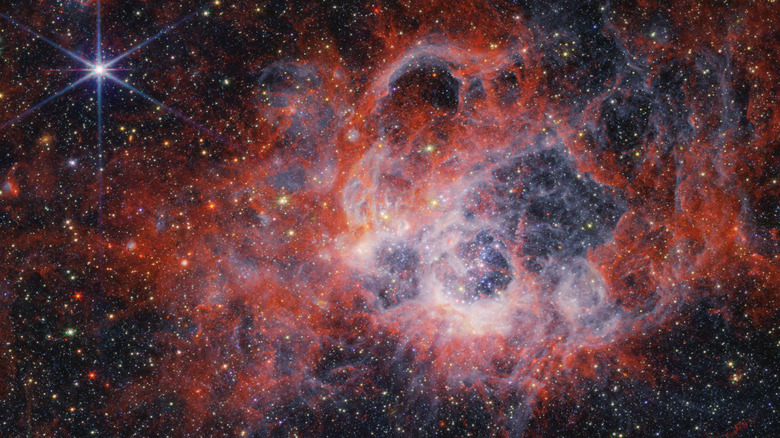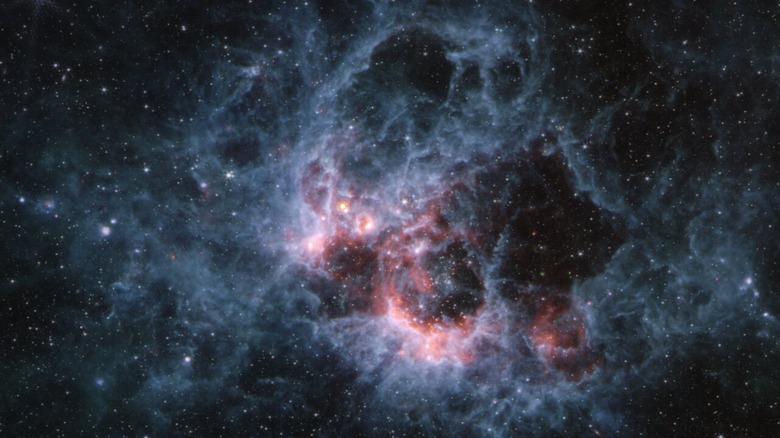This Gorgeous Cloud Is The Birthplace Of Some Of The Hottest Stars In The Universe
The James Webb Space Telescope allows astronomers to peer deep into parts of the universe that are vastly different from our solar system, like enormous clouds of dust and gas where stars are being born. A pair of new images from the telescope shows the stunning vista of the star-forming region NGC 604, located 2.73 million light-years away in the Triangulum Galaxy.
The Triangulum Galaxy is relatively close to the Milky Way, and it's part of our same galactic group. That allows Webb to capture a gorgeous, clear image of the star-forming region, which shows some of the details of this dusty scape full of bright young stars.
Within the galaxy's dust and gas live some of the hottest and most massive stars, called B-types and O-types. There are more than 200 of these hot, massive stars in an early phase of life. The O-type stars are massive and can be a type called a supergiant, getting as large as 200 times the mass of the sun and glowing incredibly brightly.
Astronomers look to NGC 604 to study these monster stars when they are in their infancy.
Viewed in two wavelengths
The James Webb Space Telescope took several images of NGC 604 using its Near-Infrared Camera (NIRCam) and the Mid-Infrared Instrument (MIRI). All four of Webb's instruments operate in the infrared wavelength, which is the part of the electromagnetic spectrum beyond visible light. Infrared wavelengths are longer than those we can see.
That enables the telescope to see things that would be invisible in visible light (or the optical wavelength). Telescopes like Hubble operate in the optical, so having Webb, which can see in the infrared is complementary. As the names of Webb's instruments suggest, they operate in different parts within the infrared spectrum: the near-infrared and the mid-infrared. This is why the two instruments get slightly different views of the same object as they look at different wavelengths they see different phenomena.
The image at the top of the page, for example, is the NIRCam image, and it shows molecules called polycyclic aromatic hydrocarbons in orange. It also shows molecular hydrogen in red, where the stars are forming, and ionized hydrogen (which experiences ultraviolet radiation) in white and blue.
The image in this section is from MIRI. The glow here comes from the cooler gas and dust packed around the center of the region.
Peering at star formation
There are also many more stars visible in the background of the NIRCam image than the MIRI, because hot stars give off high levels of radiation in the near-infrared. The stars in the MIRI image include cooler supergiants, which have lower temperatures but puff up to become very large.
The brightest stars in the NIRCam image are recently born massive stars. By examining the images, you can see some effects that these young, massive stars have on their surroundings. There are two particularly bright stars near the center giving out so much radiation that they are carving out spaces in the dust, forming the nebula and leaving a hole in the structure.
To give you an idea of how far these effects reach, the structure of NGC 604 is around 1,300 light-years across, making it incredibly vast.
You can get yet another view of this special nebula thanks to an image taken by the Hubble Space Telescope in 1996, showing a visible light version of the view. If you zoom in on this image, you can also see the remarkable improvement in the resolution of images over the last thirty years, by seeing how much less detail there is in this image compared to the new Webb image above.

